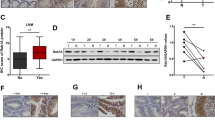Abstract
Rab31, a member of the Ras superfamily, is reported to play a role in tumor development and progression. However, the detailed role of Rab31 in proliferation and apoptosis of cancer cells is still unclear. Here, we used different cell lines, such as glioblastoma, and cervical cancer, to investigate the role of Rab31 in cancer progression. We found that Rab31 promotes U87 and SiHa cell proliferation via activation of G1/S checkpoint transitions, accompanied with an increase of cyclin D1, cyclin A, and cyclin B1. Meanwhile, Rab31 inhibits U87 and SiHa cell apoptosis, and decreased the BAX and PIG3 expression, but enhanced BCL2 expression. In addition, Rab31 induces N-cadherin, Vimentin, and Snail expression, and inhibits E-cadherin expression to regulate proliferation and migration. Besides, we observed that ERK1/2 and PI3k/AKT pathways are required for Rab31-induced cell proliferation and migration. In vivo, the knockdown of Rab31 suppresses tumor mass growth. In conclusion, our data highlight the crucial role of Rab31 in cancer progression, proliferation, and apoptosis, and indicates that Rab31 may be a useful and effective target for the clinical therapy of most cancers.




Similar content being viewed by others
References
Cheng KW, Lahad JP, Gray JW et al (2005) Emerging role of rabgtpases in cancer and human disease. Cancer Res 65:2516–2519
Chua CE, Tang BL (2015) The role of the small gtpase rab31 in cancer. J Cell Mol Med 19:1–10
Jin C, Rajabi H, Pitroda S, Li A et al (2012) Cooperative interaction between the muc1-c oncoprotein and the rab31 gtpase in estrogen receptor-positive breast cancer cells. PLoS ONE 7:e39432
Grismayer B, Solch S, Seubert B et al (2012) Rab31 expression levels modulate tumor-relevant characteristics of breast cancer cells. Mol Cancer 11:62
Kotzsch M, Dorn J, Doetzer K et al (2011) Mrna expression levels of the biological factors upar, upardel4/5, and rab31, displaying prognostic value in breast cancer, are not clinically relevant in advanced ovarian cancer. Biol Chem 392:1047–1051
Serao NV, Delfino KR, Southey BR et al (2011) Cell cycle and aging, morphogenesis, and response to stimuli genes are individualized biomarkers of glioblastoma progression and survival. BMC Med Genom 4:49
Kunkle BW, Yoo C, Roy D (2013) Reverse engineering of modified genes by Bayesian network analysis defines molecular determinants critical to the development of glioblastoma. PLoS ONE 8:e64140
Woolf EC, Scheck AC (2012) Metabolism and glioma therapy. CNS Oncol 1(1):7–10
Vehlow A, Cordes N (1836) Invasion as target for therapy of glioblastoma multiforme. Biochim Biophys Acta 2013:236–244
Wen PY, Kesari S (2008) Malignant gliomas in adults. N Engl J Med 359:492–507
Parkin DM, Bray FI, Devesa SS (2001) Cancer burden in the year 2000. The global picture. Eur J Cancer 37(Suppl 8):S4–S66
Waggoner SE (2003) Cervical cancer. Lancet 361:2217–2225
Miyazawa J, Mitoro A, Kawashiri S et al (2004) Expression of mesenchyme-specific gene Rab31 in squamous cell carcinomas of the oral cavity. Cancer Res 64:2024–2029
Shell S, Park SM, Radjabi AR et al (2007) Let-7 expression defines two differentiation stages of cancer. Proc Natl Acad Sci U S A 104:11400–11405
Langelotz C, Schmid P, Jakob C et al (2003) Expression of high-mobility-group-protein HMGI-C mRNA in the peripheral blood is an independent poor prognostic indicator for survival in metastatic breast cancer. Br J Cancer 88:1406–1410
Sakamoto H, Sakamaki T, Kanda T et al (2004) Vascular endothelial growth factor is an autocrine growth factor for cardiac myxoma cells. Circ J 68:488–493
Hata AN, Engelman JA, Faber AC (2015) The BCL2 family: key mediators of the apoptotic response to targeted anticancer therapeutics. Cancer Discov 5(5):475–487
Malumbres M, Barbacid M (2009) Cell cycle, CDKs and cancer: a changing paradigm. Nat Rev Cancer 9:153–166
Acknowledgments
We greatly thank other members of our lab for valuable suggestions and writing.
Conflicts of Interest
The authors indicated no potential conflicts of interest.
Author information
Authors and Affiliations
Corresponding author
Rights and permissions
About this article
Cite this article
Pan, Y., Zhang, Y., Chen, L. et al. The Critical Role of Rab31 in Cell Proliferation and Apoptosis in Cancer Progression. Mol Neurobiol 53, 4431–4437 (2016). https://doi.org/10.1007/s12035-015-9378-9
Received:
Accepted:
Published:
Issue Date:
DOI: https://doi.org/10.1007/s12035-015-9378-9




